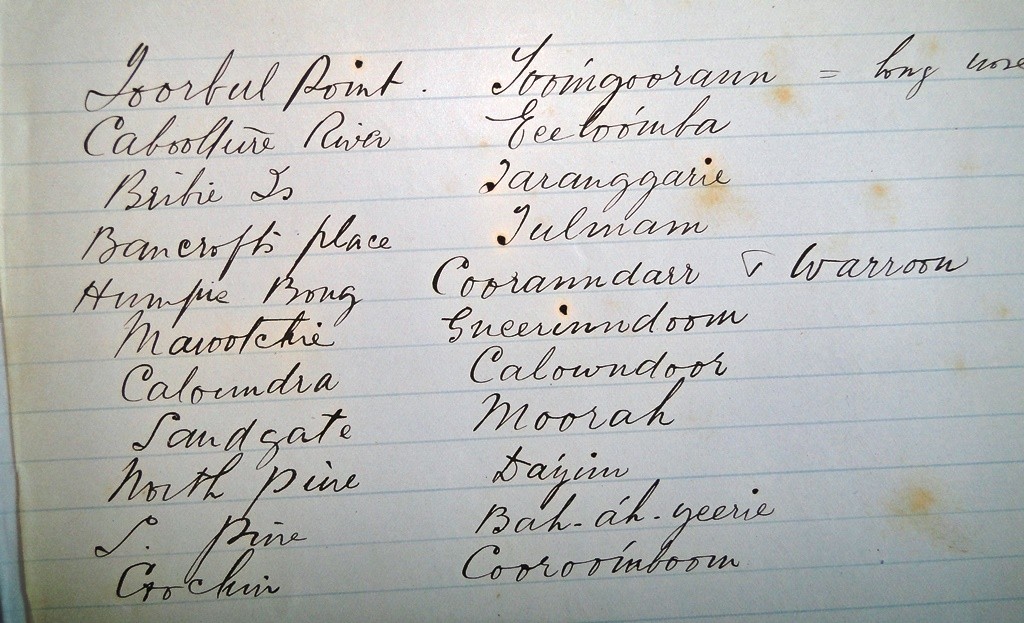
South-East Queensland Placenames, Meston.
Aboriginal place names generate a lot of discussion regarding meanings, translations, etc. – in fact, over the course of 2019, the International Year of Indigenous Languages, State Library received a steady flow of requests asking for meanings or origins of place names across South-East Queensland. In response, State Library developed a new Resource Guide for Aboriginal Placenames of South-East Queensland which lists over 100 place names, including Brisbane suburbs and their Aboriginal meaning or origin.
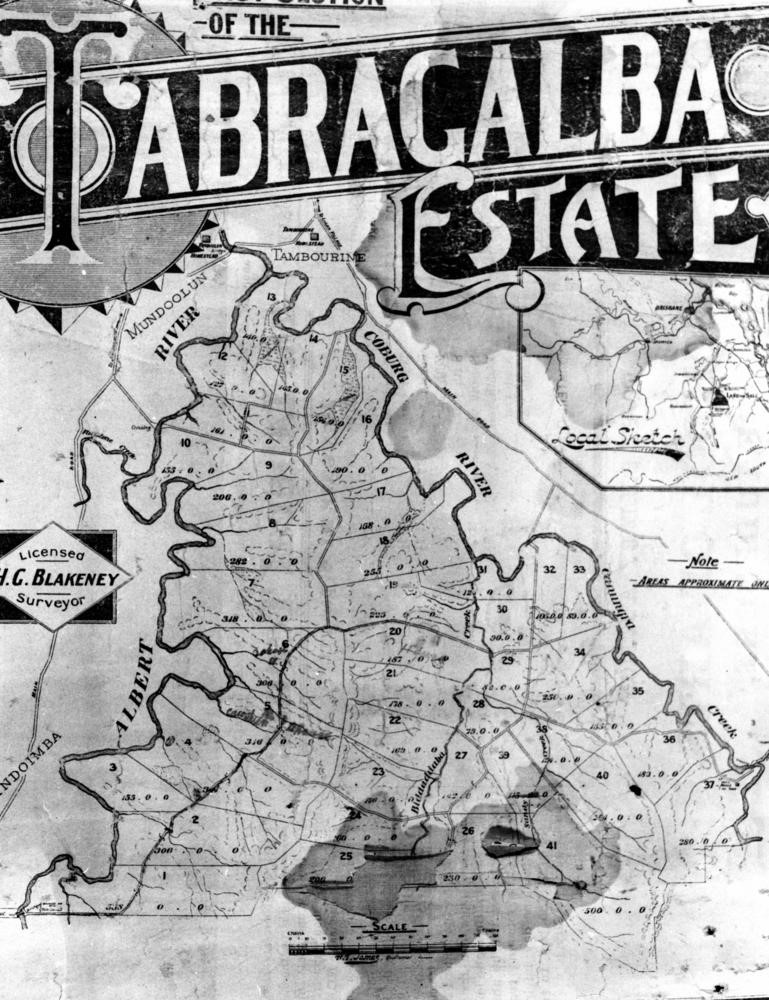
Survey plan for the area of the Tabragalba Estate. Negative number: 195248
It should be acknowledged that the landscape of South-East Queensland had traditional names prior to the settlement of Moreton Bay in 1824. Some have been maintained in place names or landmarks, others have been lost and replaced by introduced names or anglicised versions.
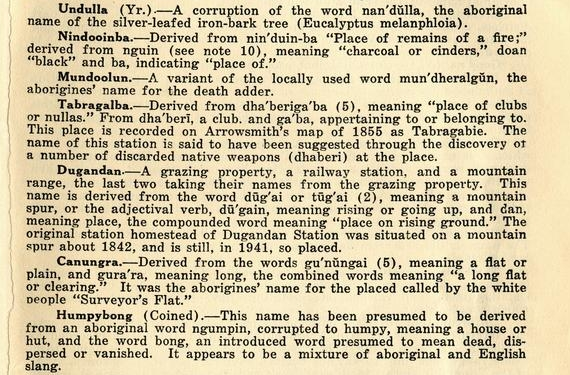
F J Watson, Aboriginal Placenames.
Many Aboriginal traditional place names had a more practical meaning or source. The traditional names may have referred to animals or plants found there; for example, Bulimba, a suburb in Brisbane, is anglicised from the Yuggera / Goenpul language: Bulimba which means ‘place of magpie lark (peewee)’ . -Ba, -bah, -da, -dah as a suffix ending in Aboriginal languages generally refers to 'place of'.
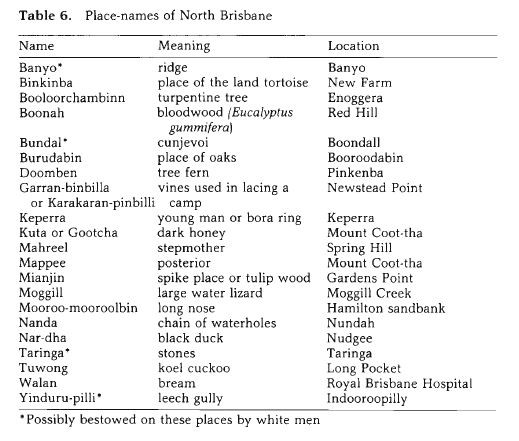
Place-names of North Brisbane, J G Steele (1984)
This theme is explored in Rod Milne's publication Dahs and bahs: Aboriginal placenames of Southern Queensland and is a great starting point for exploring Aboriginal place names in Southern Queensland. Another excellent source for the South-East Queensland corner is F J Watson's Vocabularies of Four Representative Tribes of South-East Queensland which lists approximately 200 place names and their Aboriginal meanings and origins as part of the appendixes. Watson identifies that the suffix -pilly / pilli refers to ‘a gully’, hence we have Indooroopilly = 'gully of the leeches'; Yerongpilly = 'sandy or gravelly gully'; Mutdapilly = 'sticky/muddy gully'; and Jeebropilly = 'gully of the sugar glider'.
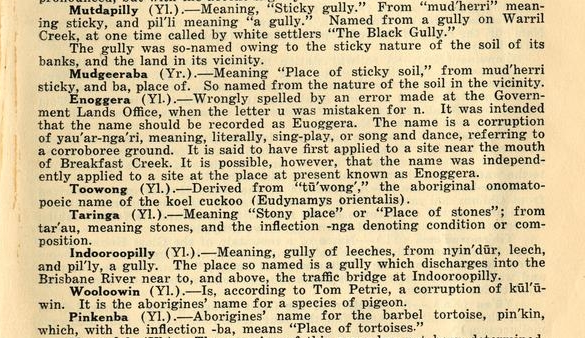
Selection of placenames, F J Watson (1945).
Often landmarks and placenames were some of the first language material documented and they provide important clues to how Aboriginal and Torres Strait Islander languages are constructed and used across Queensland communities.
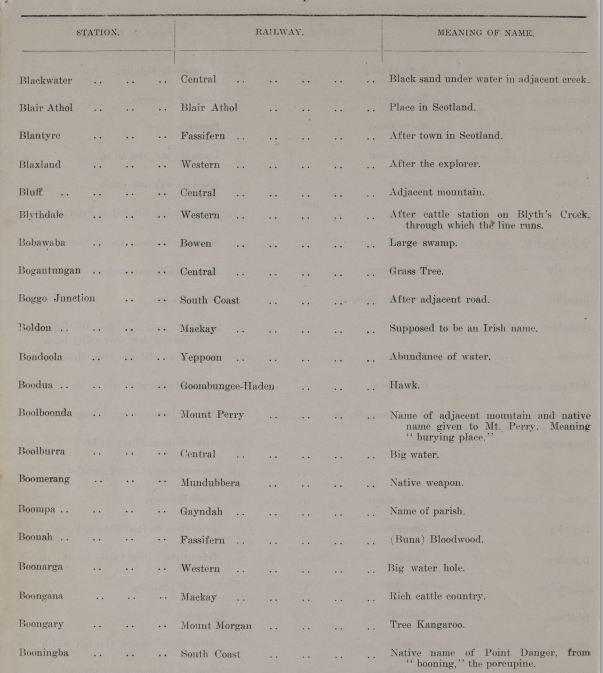
Nomenclature of Queensland Railway Stations, 1914.
Early Surveyors such as John Oxley named geographical features after Government Officials, e.g. Brisbane River, Port Macquarie. Thomas Mitchell, his predecessor as NSW Surveyor-General, took a different approach and encouraged his staff to 'consider the native name of a river to be the proper one in all cases where it happens to be short, and easily pronounced'. This advice applied to official placenames and was taken up on occasions; Namoi or 'Big River' is one such example; Goondiwindi is another example which referred to the 'bird droppings on a roosting spot on the McIntyre River'.

Macintyre River Bridge near Goondiwindi, ca. 1890.
Colonial placenames tended to be based on descriptions, e.g. Bustard's Bay, Point Lookout, Sandy Cape, Rocky Creek, Magnetic Island, etc. Others were named after people such as Cape Howe, Hervey Bay, Townsville, etc. In the 1800's settlers imposed names from their homeland onto the Australian landscape, including Esk, Killarney, Ipswich, Somerset, Dundee, etc. So we have Helidon Spa at the foot of the Toowoomba range named after an early pastoral run - it just doesn't have the same flair as Woonarrajimmi from a local Yuggera Creation story which refers to ‘where the clouds fell down’!
In 2019 the International Year of Indigenous Languages, it is a timely reminder to find out more about the local Aboriginal and Torres Strait Islander placenames.
Sources
Survey plan for the area of the Tabragalba Estate. Negative number: 195248
"McIntyre River Bridge at Goondiwindi" API-14 Album of Views of Brisbane, Ipswich, Warwick and Goondiwindi ca. 1893.
Desmond Crump
Indigenous Languages Coordinator, State Library of Queensland
State Library of Queensland Aboriginal and Torres Strait Islander Languages Webpages
State Library of Queensland Aboriginal and Torres Strait Islander Languages Map
Jarjum stories: A kuril dhagun showcase focusing on children’s books and Aboriginal and Torres Strait Islander languages. 19 October 2019-10 May 2020.
Spoken: celebrating Queensland languages: A major exhibition exploring the survival and revival of Aboriginal and Torres Strait Islander languages throughout Queensland. Join in the many talks and events to celebrate the rich and diverse languages spoken today. 21 November 2019 - 19 April 2020.
References and further reading
This is only a selection from the State Library Collections – for a comprehensive listing of print and electronic materials relating to Aboriginal and Torres Strait Islander languages, including placenames, use the One Search facility: One Search -Catalogue
Brisbane History Group (1990) Brisbane: local, oral and placename history. Brisbane History Group: Brisbane. G 994.31 1990
Helon, G. (1994) The Goreng Goreng tribe of South-East Queensland: its’ traditional tribal territory, clan divisions and proper names. (Map) Gurang Land Council: Bundaberg. MAPS 840 1998 02000 F
Hercus, L.; Hodges, F and Simpson, J. (2002) The land is a map: placenames of Indigenous origin in Australia. Q 919.4003 LAN
Holmer, N. (1983) Linguistic Survey of South-Eastern Queensland. Australian National University: Canberra. J 499.15 HOL
Kerwin, D. (2011) “Language and
Landscape: European words in Aboriginal spaces”. Out of the Port session. Available online as a webcast via State
Library Website: http://enc.slq.qld.gov.au/audio/slq/pp/mp3/OP/LanguageLandscape.mp3
Lamington Natural History Society (199?) Place names in Lamington National Park. VF 910.3 pla
OM64-17 Archibald Meston Papers
Milne, R. (1993) Dahs and bahs: Aboriginal Placenames of Southern Queensland. Q 910.014 MIL
Nelson, C. J. (1993) The Valley of the Jagera. P 994.32 nel
Queensland Place Names Board (1963) Interim Gazetteer of Queensland Place Names. REF 919.43 1963
Simpson, J. (1975) Placenames of Southern Queensland. P 910.014 sim
Steele, J. G. (1984) Aboriginal Pathways in Southeast Queensland and the Richmond River. Q 994.3102 ste
Watson, F. J. (1944) Vocabularies of Four Representative Tribes of South Eastern Queensland. REFJ 499.15 wat
Websites
Australian Government Geoscience Australia Place Name Search.
Queensland Government Department of Natural Resources, Mines and Energy online Place Names Search
State Library of Queensland Aboriginal Placenames of South-East Queensland Resource Guide.
Comments
Your email address will not be published.
We welcome relevant, respectful comments.